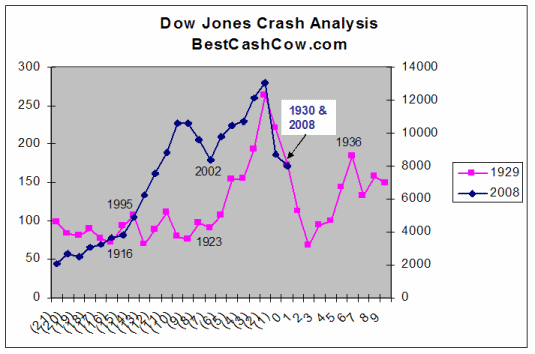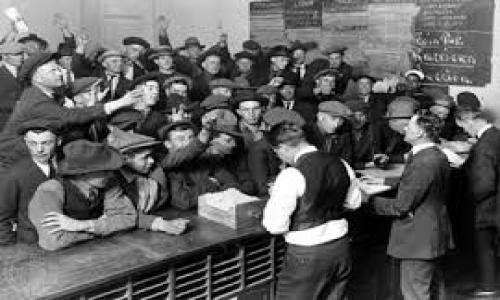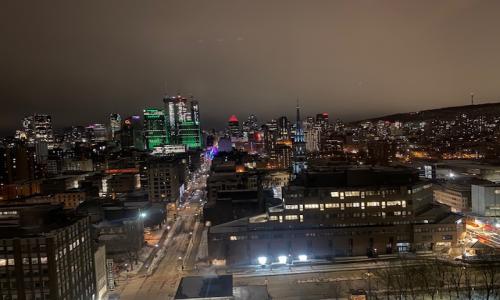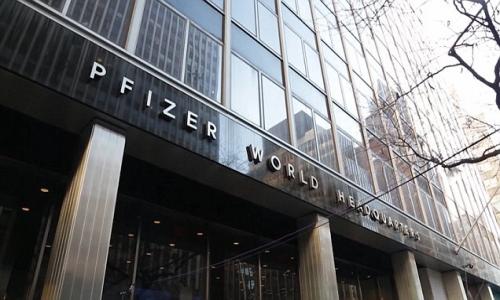Today, as I watched the Dow sink below 8,000, I wondered how the sell-off of the last six months compares to the sell-off during the Great Depression. The chart below shows what I found. To create it, I graphed historical data taken from the DJ Indexes website for the Dow Jones Industrial Average.

Let me explain how to read the chart.
The years 1930 and 2008 are time 0 on the x axis of the graph. I then looked at the 21 years before 1930 and 2008 to see how the markets performed before the 1930 and 2008 crashes. I also charted the 10 years after the crash in 1930, represented by the positive numbers on the X axis. The left Y axis shows the Dow's price during the early part of the 20th century and the right Y axis shows the Dow's price in more modern times. One other note on the methodology is that I used the closing price of the Dow on November 11 of each year.
As you can see by looking at the blue and pink lines, before both crashes there was a sharp run-up in the value of the Dow. But the data shows that the pre-crash bubble is much bigger now than it was prior to the Great Depression. While the Dow increased about 2.5x during the priod 21 years before the crash of 1929-1930, it increased over 6X from 1988 to 2008.
In 1929, with Black Friday, the Dow began to deflate and it hit a bottom in 1932. By that point, the Dow was down almost 75% from its peak a few years earlier. Today, the Dow has fallen about 42% from its high of 13,850. As the chart shows, if this economic downturn is not over and comes close to approaching the early severity of the Great Depression, then the Dow is not done falling. It's important to note that the largest damange to the market happened at the beginning of the Depression. While economic problems continue until the beginning of World War II, the stock market began to recover from its lows in 1936. What does that mean? It means that even if our current downturn doesn't last as long as the Depression, it could be as deep for a concentrated period of time, and during that time cause further equity losses.
I don't usually use Wikipedia as a source but I came across this entry on the Great Depression and thought it appropriate. You can decide if there are parallels to today:
The Great Depression was not a sudden total collapse. The stock market turned upward in early 1930, returning to early 1929 levels by April, though still almost 30 percent below the peak of September 1929.[6] Together, government and business actually spent more in the first half of 1930 than in the corresponding period of the previous year. But consumers, many of whom had suffered severe losses in the stock market the previous year, cut back their expenditures by ten percent, and a severe drought ravaged the agricultural heartland of the USA beginning in the northern summer of 1930.
In early 1930, credit was ample and available at low rates, but people were reluctant to add new debt by borrowing. By May 1930, auto sales had declined to below the levels of 1928. Prices in general began to decline, but wages held steady in 1930, then began to drop in 1931. Conditions were worst in farming areas, where commodity prices plunged, and in mining and logging areas, where unemployment was high and there were few other jobs. The decline in the American economy was the factor that pulled down most other countries at first, then internal weaknesses or strengths in each country made conditions worse or better. Frantic attempts to shore up the economies of individual nations through protectionist policies, such as the 1930 U.S. Smoot-Hawley Tariff Act and retaliatory tariffs in other countries, exacerbated the collapse in global trade. By late in 1930, a steady decline set in which reached bottom by March 1933.
The quote doesn't touch on the obvious parallels in the banking system. Although there haven't been as many bank failures, the magnitude of the financial failures today are enormous - Bear, Lehman, Fannie, Freddie, Wachovia, Washington Mutual, Countrywide, National Citi, AIG. I realize not all of these were failures but many of the banks listed were purchased at firesale prices to prevent a failure.
The question to ask yourself about this recession is whether you think it's like the relatively mild downturns of 2001-2002, and 1991-1992 and even 1980 or is it really the worst economic downturn since the Great Depression? Because if you believe the latter, then that blue line has further to fall.
For an update on this article from August 3, 2011, click here.














Comments
Oneslip
June 04, 2009
I think the major comparison is the fact that in both cases of now & the depression is that it is a credit crisis, the 20's boom times were based on leverage just as the late 90's and early 2000's. In fact the ratios are even more expanded today then in the past. The market has been rallying since March 6th but I feel that this is still a bear market rally, the fundementals are still very horrible in fact the counrty as whole has suffered a huge balance sheet issue. The same thing happened in the 30's, the market rallied 20% and people got confident to get back in and then the market just descended for it's 75% drop, I do think the same can happen. I also feel the S&P is still overpriced & the yield is too low.
I would love to be more positive and I have certainly enjoyed watching my portfolio climb out of the hole but longer term I am not confident.
Is this review helpful? Yes:0 / No: 0
Randy
October 05, 2009
I think the market today is going through an accelerated version of the 1930s. The rise that peaked in 1936 is happening now as government cash pours into the economy. Look for a downturn over the next 6 mos. as the cash works its way through and then investors say: what's next?
Is this review helpful? Yes:0 / No: 0
Gus
October 31, 2009
Market back to 8,000. Then it might stabilize.
Is this review helpful? Yes:0 / No: 0
MAX
November 17, 2009
although it is only updated though Oct. there is a comparision
http://img62.imageshack.us/img62/9031/1929to2009092309.png
Is this review helpful? Yes:0 / No: 0
martin
December 15, 2009
Awesome dear i really like all your efforts that you have done for the development of this blog. You are really a gorgeous and successful person of this world. I really like your ideas and suggestions that you have shared with the readers.
free scripts
Thanks a lot
Is this review helpful? Yes:0 / No: 0
redneckinsect
December 20, 2009
i like the chart comparison, but agree with chuckoo on the y axis thingy.as for the 5 cents for bread thingy you have to also compair our present incomes also. i do agree with the fact that the govt. is incorraging bad spending habbits and should just give a flat tax cut if any.
as for what the markets will do no one knows we are all guessing, but my guess is that it will not be quite as bad as the depression. what little money i have in the market i pulled out and will put back in around feb. march april of 2010.
Is this review helpful? Yes:0 / No: 0
Sarb Gill
January 03, 2010
Its amazing how things can change so fast. Some people are now under the impression that things have gotten as bad as they are going to get.
Here, people in BC are not accepting the real estate bubble, even when you having esclating inflaiton, job losses, and people are putting down just 5%.
Are we heading towards another depression? Well some countries are already in one and the rest of the world will follow in the next 1-2 years. These are hard times and in this type of enviorment new wars are guaranteed to start.
The good thing is people will devlop class again dress nice, and believe in god, worship attendence to increase.
After this next period of hyper-inflation the DOW will crash to around 3500. The US dollar and the British Pound will get hit really hard, maybe loosing 40-60% versus other currencies, but the whole world is priting money and fooling their people to believe a recovery is in order. This will lead to revolution in 2-3 years.
The only way to protect yourself is to buy real assets, preferable gold and agriculture (inventories are very low and prices do not reflect that, which will cause over consumption and a lack of incentive for farmers to use more fertalizers to increase yields).
Is this review helpful? Yes:0 / No: 0
Amadeo
February 17, 2010
Sarb could be partly right.
What is the formula to get out of this mess?
Should we go back to zero and then keep wages
and prices steady?
Is this review helpful? Yes:0 / No: 0
Jakey T
February 19, 2010
I definitely think that the stock market, and our economy as a whole, has much further to drop. Despite the stimulus package as a means to attempt to stabilize our economy to some degree, it's obvious that it didn't manage to fully fix the situation, or to provide a long-term means of keeping our economy from falling any more. Mr. Obama, i sure hope you know what you're doing with our money, because what we need right now isn't someone who's going to play political games and spend it all go gain honors or more prestige, we need someone who will play a conservative role with our money, and bring out economy back to being prosperous.
Is this review helpful? Yes:0 / No: 0
D.J.O.
March 08, 2010
What is of great concern to me is the possibility of civil unrest. Our government no matter how much they try to stimulate the economy will be unable to satisfy
the general population expectations. We cannot spend our way to prosperity.
Short term view of stock prices should continue to rise
until a majority of the stimulas money has been allocated.
Is this review helpful? Yes:0 / No: 0
Add your Comment
or use your Google account
or use your BestCashCow account